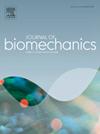Potential recovery of arm strength capability in a post-breast cancer treatment population: A simulation analysis
IF 2.4
3区 医学
Q3 BIOPHYSICS
引用次数: 0
Abstract
Arm dysfunction often follows breast cancer treatments. Diversity in treatment makes it challenging to explore how exercise impacts dysfunction in survivors. This study computationally simulated treatment scenarios to identify a theoretical maximal producible force (aided by muscular training) and the internal muscle forces required to produce that force in a compromised system. An existing shoulder model was modified to reduce the capacity of certain muscles to mimic lower-functioning breast cancer populations. Capacity of muscles were increased to emulate training, with maximums dictated based on damage from treatment-specific scenarios (radiation, chemotherapy, combination treatment). Maximum force, torque, and muscle forces were extracted for each treatment scenario, a maximum (unaltered) non-cancer reference, and baseline (breast cancer survivor) force, across 2 maximum isometric force exertions (adduction and internal rotation). Overall, 70–80 % of strength was recoverable with successful retraining. Specifically, for both exertions’ recruitment of primary movers (adductors or internal rotators) and scapular and glenohumeral stabilizers, increased from the baseline level in each scenario, with highest recruitment at the non-cancer reference force level. Although no post-training scenario reached non-cancer reference control population force levels, achieving 70–80 % of force could enable more successful daily task performance, return to work and enhance overall physical self-efficacy.
乳腺癌治疗后人群臂力的潜在恢复能力:模拟分析
乳腺癌治疗后常常会出现手臂功能障碍。治疗方法的多样性使得探索运动如何影响幸存者的功能障碍具有挑战性。本研究通过计算模拟治疗方案,确定理论上可产生的最大力量(通过肌肉训练辅助),以及在受损系统中产生该力量所需的肌肉内力。对现有的肩部模型进行了修改,降低了某些肌肉的能力,以模拟功能较低的乳腺癌患者。增加肌肉能力以模拟训练,最大值则根据特定治疗方案(放疗、化疗、综合治疗)造成的损伤来确定。针对每种治疗方案、最大(未改变的)非癌症参考值和基线(乳腺癌幸存者)力,在 2 个最大等长力运动(内收和内旋)中提取最大力、扭矩和肌肉力。总体而言,通过成功的再训练,70%-80% 的力量可以恢复。具体来说,在这两种用力中,主要运动者(内收肌或内旋肌)以及肩胛骨和盂肱稳定器的募集量在每种情况下都比基线水平有所增加,其中非癌症参考力水平的募集量最高。虽然训练后没有一个方案达到非癌症参考对照人群的力量水平,但达到 70%-80% 的力量水平可以使日常任务的执行更加成功,重返工作岗位,并增强整体的身体自我效能感。
本文章由计算机程序翻译,如有差异,请以英文原文为准。
求助全文
约1分钟内获得全文
求助全文
来源期刊

Journal of biomechanics
生物-工程:生物医学
CiteScore
5.10
自引率
4.20%
发文量
345
审稿时长
1 months
期刊介绍:
The Journal of Biomechanics publishes reports of original and substantial findings using the principles of mechanics to explore biological problems. Analytical, as well as experimental papers may be submitted, and the journal accepts original articles, surveys and perspective articles (usually by Editorial invitation only), book reviews and letters to the Editor. The criteria for acceptance of manuscripts include excellence, novelty, significance, clarity, conciseness and interest to the readership.
Papers published in the journal may cover a wide range of topics in biomechanics, including, but not limited to:
-Fundamental Topics - Biomechanics of the musculoskeletal, cardiovascular, and respiratory systems, mechanics of hard and soft tissues, biofluid mechanics, mechanics of prostheses and implant-tissue interfaces, mechanics of cells.
-Cardiovascular and Respiratory Biomechanics - Mechanics of blood-flow, air-flow, mechanics of the soft tissues, flow-tissue or flow-prosthesis interactions.
-Cell Biomechanics - Biomechanic analyses of cells, membranes and sub-cellular structures; the relationship of the mechanical environment to cell and tissue response.
-Dental Biomechanics - Design and analysis of dental tissues and prostheses, mechanics of chewing.
-Functional Tissue Engineering - The role of biomechanical factors in engineered tissue replacements and regenerative medicine.
-Injury Biomechanics - Mechanics of impact and trauma, dynamics of man-machine interaction.
-Molecular Biomechanics - Mechanical analyses of biomolecules.
-Orthopedic Biomechanics - Mechanics of fracture and fracture fixation, mechanics of implants and implant fixation, mechanics of bones and joints, wear of natural and artificial joints.
-Rehabilitation Biomechanics - Analyses of gait, mechanics of prosthetics and orthotics.
-Sports Biomechanics - Mechanical analyses of sports performance.
 求助内容:
求助内容: 应助结果提醒方式:
应助结果提醒方式:


